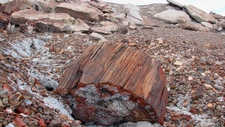Using Fossils to Understand Past Environments
Supporting

TEKS Objective
The student is expected to identify fossils as evidence of past living organisms and the nature of the environments at the time using models.
Essential Understanding
The student knows Earth's surface is constantly changing and consists of useful resources.
Science Background
Fossils, Rocks and Layers: US Geological Survey (website) - This online book by geologists, L. Edwards and J. Pojeta, Jr., covers time scales, rocks and layers, fossils, and fossil succession.
Fossils: National Park Service (website) - Informative text and photos about fossils at the Grand Canyon, which are discussed by class (terrestrial, marine, and recent fossils).
Signature Lesson
Learning About Fossils Through Hands-On Science and Literacy: The Phio State University (website) - With the lesson how do fossils form? Students will understand different types of fossils and how they are formed.
Learning About Fossils Through Hands-on Science and Literacy
The Phio State University, www.nps.gov
- Supporting Lessons
- Extensions
- Assessment Ideas
- Literature Connections
- Related
TEKS - Additional Resources
Supporting Lessons
Getting Into the Fossil Record: University of California Museum of Paleontology (website) - Complete interactive teaching module on fossils, with pre- and post-assessments.
Elaboration Lessons and Extensions
Fossil Frolic: National Park Service (PDF) - Students learn about different marine environments from 300 million years ago, in which limestone was deposited and many fossils formed over time.
Assessment Ideas
1. Have students describe the environment and habits of an ancient animal and explain how it might have become a fossil.
2. Have students imagine that their food sources have disappeared due to a major change in their environment, such as an ecological disaster. Have them answer the following questions, either in writing or verbally: What could you do to survive? Would you move away? How would the other members of your food web survive?
Literature Connections
Dinosaur Mummies. Millner, Kelly (ISBN: 1-58196-034-4)
A Dinosaur Named Sue: The Story of the Colossal Fossil, The World's Most Complete T. Rex. Relf, Patricia (ISBN: 439099854)
Fossils Tell of Long Ago. Aliki (ISBN-10: 0064450937)
The Best Book of Fossils, Rocks, and Minerals. Perrault, Chris (ISBN-10: 075345274X)
Fossil Shark Teeth of the World. Cocke, Joe (ISBN-10: 0971538131)
Additional Resources
The Use of Fossils in Interpreting Past Environments: University of Wyoming (PDF) - Information on fossils and the environments in which they formed, use of museum collections to learn and teach about fossils, and directions for making molds and casts.
TEKS Navigation
Grade 5
Need Assistance?
If you need help or have a question please use the links below to help resolve your problem.

Comments